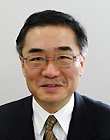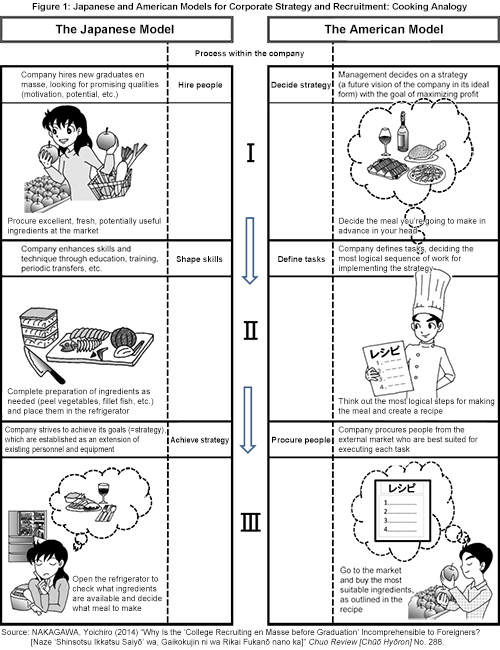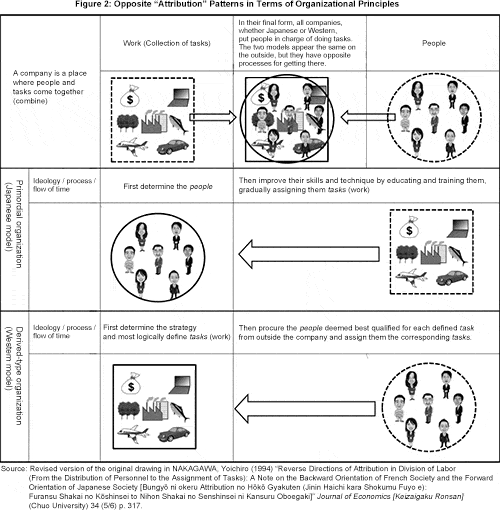Top>Opinion>New Grad Mass Recruiting
 Index
Index

Yoichiro Nakagawa [profile]
New Grad Mass Recruiting
Yoichiro Nakagawa
Professor, Faculty of Economics, Chuo University
Area of Specialization: Economic history of contemporary France
No Early New Grad Mass Recruiting in Western Companies
The mass recruiting of undergraduates remains a standard practice in Japanese companies. To be more precise, a hiring system in which undergraduates (college students set to graduate the next academic year) are recruited en masse (hundreds of graduates may be recruited at a time by large companies) regularly during a specific time of year (from spring to summer, a year before graduation) functions as a very normal procedure in Japan.
This Japanese hiring system, in which college students without work experience or qualification of skills or technique are recruited en masse before graduation, seems usual to us Japanese. But try asking a foreign businessperson about mass recruiting college students before graduation. The general manager of an American company will say something like, “The idea of recruiting a group of students with no employment history or college diploma—i.e. no qualification of skills—one year in advance before deciding what positions they will fill is unbelievable!”
American Companies are Hierarchical Organizations
American companies have a clear-cut hierarchical structure generally characterized by 1) explicit description of jobs, 2) concentration of authority, and 3) a top-down chain of command.
In American companies, a new employee’s job description is previously defined when he or she joins the company. In other words, there are clear definitions of the tasks he or she performs (explicit description of jobs). The distinction between “those who manage” and “those who are managed” is especially rigid. The most representative example of this is the position of “general manager.” The general manager is a person whose job is to direct (manage) matters in general, who literally has full authority over everything, including planning, research and development, production, sales, finance and accounting, human resources, and general affairs (concentration of authority). Since all the authority is concentrated in the general manager, the policies and plans he or she decides on are absolute.
In the USA, about 10% of new graduates find their first jobs through college placement offices, but this custom referring to College Recruiting in the USA is quite different from the Japanese practice. In organizations like American companies characterized by explicit description of jobs, concentration of authority, and a top-down chain of command, the idea of regularly hiring and training new graduates is exceptionally reserved only for small minority running on the “fast track”. The aim of corporate management is nothing but the maximization of profit in terms of the collection of industry-ready personnel as needed from inside and outside labor markets under the authority of the head office.
Global Companies Decide Their Strategy First
Camel Yamamoto (Seiichi Yamamoto) uses an excellent metaphor to describe the American model of organizational management from the perspective of corporate strategy: “The American way is to first come up with a strategy and then perform the work in a top-down manner. It’s like deciding the meal you’re going to make and then gathering the needed ingredients” (The Asahi Shimbun, May 3, 2013). So in the American system, the management first decides the corporate strategy. Top executives imagine the ideal future of the company. A possible route leading to this ideal becomes the strategy. Steps for implementing the strategy are mapped out and tasks (individual job descriptions) are determined. The company then recruits and hires people in the labor market who are best qualified for carrying out these predetermined tasks, assigning each person the corresponding task. In this system, starting with the strategy and deciding tasks in advance are of paramount importance. If we put the sequence of decisions into chronological order, it looks like this: strategy → tasks → people.
On the other hand, the Japanese model has the exact opposite sequence of decisions: 1) assess current resources, i.e. personnel and equipment, 2) provide the education and training these personnel following career development program, and 3) achieve goals for the future. If I were to caricature the Japanese model in the style of Camel Yamamoto, it would be like replenishing ingredients in advance by selecting fresh, high quality food at the market at regular intervals (“mass college recruiting of prospective new graduates”), as shown in Figure 1. The food is then dressed and prepared as needed and placed in the refrigerator (“in-house education, training, and practice” and internal promotion). Finally, when it’s time to cook, the refrigerator is first opened and checked to see what ingredients are available before deciding what meal to prepare.

Figure 1: Japanese and American Models for Corporate Strategy and Recruitment: Cooking Analogy
(Click to expand)
The West and Japan: Opposite Attribution Patterns
There seems to be a crucial difference between the Japanese and Western approaches to assembling an organization and managing it. What aspects are different and in what ways?
In an organization, there are people doing some kind of work. People and work “combine,” so to speak, to reach the final state of “people doing work.” There are actually two different ways for this to take place: people are chosen and then work is assigned to them or, conversely, the work is chosen and then people are assigned to it. Figure 2 visually represents these contrasting “attribution” patterns. In American companies (globalized companies), the approach to forming divisions of labor is, as we’ve seen, to first define the tasks and then bring in the people best suited to these tasks from the external market—an unquestionably “work ← people” arrangement. Japanese companies first select their employees through the mass hiring of new graduates and then gradually assign them increasingly sophisticated tasks through in-house training. Thus, if we apply the “attribution” hypothesis laid out in this article, the Japanese model follows a “people ← work” attribution pattern, in which people are first chosen and then work is assigned to them. In other words, Western and Japanese companies have attribution patterns that operate in opposite directions.
Conclusion: The Japanese System Will Survive as Long as Mass College Recruiting Continues
In this article, I have presented the fact that globalized companies and Japanese companies have diametrically opposite organizational principles, or ways of bringing people and work together, as seen from the perspective of “attribution.” The very maintenance of a system of recruiting undergraduates and hiring them en masse when they graduate strongly suggests that the Japanese corporate system is fundamentally different from the globalized one. It is evidence that Japanese society is on track to maintain its uniqueness rather than simply join the melting pot of globalization.
- For more information, see Chuo Review [Chūō Hyōron] No. 288
 , which will be published in late July 2014 .
, which will be published in late July 2014 . - Episode of the educational program Chi no Kairo (Corridor of Wisdom) supervised by the author (Episode 62: “Motivation” on the Factory Floors that Support the Japanese Automobile Industry [Nihon no Jidōsha Sangyō o Sasaeru Genba no “Yaruki”])

- Yoichiro Nakagawa
Professor, Faculty of Economics, Chuo University
Area of Specialization: Economic history of contemporary France -
Professor Nakagawa was born in Tokyo in 1950. He graduated from the French Language Department at the School of Foreign Languages, Tokyo University of Foreign Studies in 1974, and completed the Master’s Program in International Relations at the Graduate School of Social Studies, University of Tokyo in 1976.
He received his Doctrat de 3e cycle (Ph.D. in Economic History) from the Graduate School of Social and Economic History, University of Paris (I) in 1981, and completed the coursework for the Doctoral Program in International Relations at the Graduate School of Social Studies, University of Tokyo in 1983.
After serving as Research Assistant and Associate Professor on the Faculty of Economics, Chuo University, professor Nakagawa assumed his current position in 1994. He also served as the Director of the Admissions Center (2005-2009) and the Vice President of Chuo University (2008-2009).
His main areas of research are the financial history of contemporary France, the history of the automobile industry in Japan and France, and left-wing totalitarianism. His current research projects are 1) elucidating the essence of European civilization all the way back to its origin in pastoralism (The History of Civilization from the Viewpoint of Pastoralism [Bunmei no Bokuchiku Shikan]), 2) the impact Japanese systems have had on Western industrial systems (Japanization [Japanaizēshon]), and 3) the formation, expansion and collapse of socialism (Left-Wing Totalitarianism [Sayoku Zentaishugi]). Also, he sympathizes deeply with the call for the spirit of a Japanese-language clan in Taiwan, namely, Taiwanese born and educated in the Japanese era. They began to open their mouth claiming revision of history after Lee Teng-Hui assumed the position of President in Taiwan. His secondary research theme therefore is Taiwan: The Mirror of Japan. His major publications include Research on the Financial History of France [Furansu Kinyūshi Kenkyū] (Chuo University Press, 1993), The Conquest of the World by European “Universal” Civilization [Yōroppa “Fuhen” Bunmei no Sekai Seiha] (Gakubunsha, 2003), Socialism without Violence? Crédit Mobilier under the Second Empire of France [Bōryoku Naki Shakaishugi? Furansu Daini Teisei ka no Kuredi Mobiriē] (Gakubunsha, 2004), Economic History of Europe I: Wheat, Sheep, Slaves [Yōroppa Keizaishi I: Mugi, Hitsuji, Dorei] (Gakubunsha, 2011), and Economic History of Europe II: Capital, Market and Coal [Yōroppa Keizaishi II: Shijō, Shihon, Sekitan] (Gakubunsha, 2012).
- Research Activities as a Member of Research Fellowship for Young Scientists (DC1), Japan Society for the Promotion of Science (JSPS) Shuma Tsurumi
- Important Factors for Innovation in Payment Services Nobuhiko Sugiura
- Beyond the Concepts of Fellow Citizens and Foreigners— To Achieve SDGs Goal 10 “Reduce Inequality Within and Among Countries” Rika Lee
- Diary of Struggles in Cambodia Fumie Fukuoka
- How Can We Measure Learning Ability?
—Analysis of a Competency Self-Assessment Questionnaire— Yu Saito / Yoko Neha - The Making of the Movie Kirakira Megane









